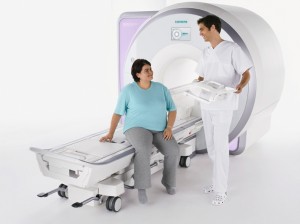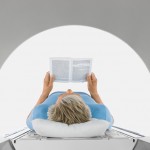Drs. Petrovitch and Staloch answer questions about the new 3.0T MRI with HealthReach Magazine
 Drs. Petrovitch and Staloch recently answered a few questions about MRI and the new Siemens Open Bore MAGNETOM Skyra 3T MRI installed at the Virginia Hospital Center with HealthReach Magazine. The following questions and answers are from the article. If you would prefer to read the magazine article itself, please click the link at the bottom of the page.
Drs. Petrovitch and Staloch recently answered a few questions about MRI and the new Siemens Open Bore MAGNETOM Skyra 3T MRI installed at the Virginia Hospital Center with HealthReach Magazine. The following questions and answers are from the article. If you would prefer to read the magazine article itself, please click the link at the bottom of the page.
Q. What is MRI and how is it used in diagnostics?
A. MRI uses a powerful magnet and radio waves to obtain detailed images of the soft tissues — organs, muscles, veins, and nerves — in the body. It is the most advanced imaging that we offer, and there are no known side effects, because there is no radiation.
MRI is used to diagnose tumors, infection, neurological conditions, and orthopedic injuries, and can be used to image virtually any part of the body. MRIs of the heart can identify structural abnormalities such as aneurysms and can visualize physiologic abnormalities such as valvular disease and heart failure. MRI can also be used for dynamic imaging to monitor bloodflow to the brain and liver, as well as evaluate the contractions of the small bowel and the muscles of the pelvic floor.
Q. Who interprets MRI results?
A. At Virginia Hospital Center, MRIs are read by fellowship trained subspecialty radiologists. Our radiologists have been trained at prestigious academic centers including UCSF, Stanford University, the Johns Hopkins University, Massachusetts General Hospital, and the University of Maryland. The radiologists work closely with your doctor to make sure you get accurate and timely results to provide you with the best care.
Q. What is it like to have an MRI?
A. Many patients find an MRI to be a relaxing experience and may even take a nap. During an MRI, the patient lies down on a padded table and is positioned so that the part of the body to be scanned is in the center of the magnet. Each exam takes about 30 minutes and the patient must lie completely still during the imaging.
Q. How does the staff make an MRI exam comfortable for patients?
A. Since all MRIs make noise during the examination, we provide our patients with earplugs or can listen to music on our sound system or their own iPods or CDs. They will still hear the MRI sounds, but not as loudly.
We know that the exam room can be chilly, so we offer all patients warm blankets.
Most importantly, we stay in constant communication with the patient. At all times during the MRI, we talk to patients and can hear them. There also is a call button for patients to press if they need us right away.

The Skyra 3.0T MRI has an open bore with increased space to provide improved patient comfort.
Q. How does an open bore MRI compare to a standard MRI?
A. It offers faster exams, more patient comfort, and sharper images. An open bore MRI is a tube that is much wider in diameter compared with a standard MRI. The larger diameter is more comfortable for the patient and results in less claustrophobia. The larger bore can also accommodate larger patients, up to 550 pounds.
Q. Can patients request open bore MRI?
A. MRI and open bore MRI are both outstanding diagnostic tools. The radiology team will tailor the exam to the appropriate machine to meet the individual needs of each patient.
Q. How do I schedule an MRI appointment?
A. MRI appointments are available seven days a week by calling 703.558.8500. Please have your physician referral and insurance information available when you call. Since the MRI uses a magnet, the appointment scheduler will ask you several safety questions about metals.
Original HealthReach Magazine article
If you have any additional questions regarding MRI, please feel free to contact any of the physicians at Northern Virginia Radiology Consultants by using the contact link form at the top of the page.
